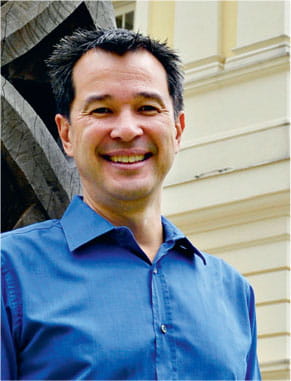Stories > Beauty in Diversity
Beauty in Diversity

TOP: Pink wedding robe embroidered with auspicious birds and flowers from the Peranakan Museum. Bottom: Blue-and-white gilded plate featuring the qilin (a mythical Chinese hooved creature) and phoenix from the Peranakan Museum.
Dr Alan Chong, Director of the Asian Civilisations Museum and the Peranakan Museum, on Singapore’s embrace of cultural differences.
BY LOW SHI PING
PHOTOS SPH LIBRARY
ne of the things that struck Dr Alan Chong when he arrived in Singapore from the United States five years ago was the “culture of chilli” in the region. The American discovered differences in the way the spice was presented, from Thailand to Goa, and between the different islands in Indonesia.
“I didn’t realise the extent of the nuances. Even when you go to a good hawker stall here, there are at least three kinds of chilli to choose from,” says the Director of the Asian Civilisations Museum (ACM) and the Peranakan Museum.
He was also fascinated by the fact that people in Singapore get along despite differences in upbringing, mother tongue and religion. “It’s a remarkably understanding place,” he says.
This multiculturalism inspired him in 2012 to steer the ACM in its current direction of celebrating the diversity that makes up Singapore. “We tell a story about trade and connectivity that has led to this blend of cultures,” he says.
As a Chinese growing up in the melting pot of Hawaii, he has always been attracted to cross-culture environments. So when the offer came to join the ACM, he jumped at it.
In addition, back then in 2010, he realised Singapore was increasingly, and still is, turning its attention to strengthening its cultural identity; this after having established itself as a regional financial and business hub. “It was an exciting time to join the team and carve out a new mission for the ACM that might reflect Singapore and the region better,” recalls Dr Chong, who has a PhD in the history of art from the Institute of Fine Arts at New York University.
Visitors to the ACM will get a stronger sense of that when parts of the museum reopen later this year after a major revamp. Aside from reorganising the exhibits based on the themes of religion, trade and belief, rather than geography, the ACM will also debut new galleries in two new building extensions.
This direction highlights Singapore’s cross-culturalism – stemming from its roots as a port city – with reference to the world. One of the exhibitions that will open next year traces the development of the port cities of Goa, Jakarta and Macau.
Says Dr Chong: “They were wonderful cities that have a colonial heritage of bringing people from all over the world. From interracial marriage to creating new languages, forms of cooking and food, these societies that resulted were a creative mix that inspired a new way of living. Singapore is the inheritor of this tradition.”
IMPORTANT LESSONS
For him, the ACM is a reminder of the good that can come from embracing cultural differences.
He says: “We show how the past provides us with important lessons about tolerance. Because of wars and political disagreements, we often-times perceive the co-existence of different cultures as conflict. We forget that there have also been strong areas of understanding, often through trade, travel and contact.”

RIGHT: Dr Alan Chong outside the Asian Civilisations Museum.
He believes that Singapore offers important lessons in this regard. For instance, it facilitates an environment of diversity through accommodating different religious buildings on the island. He says: “You can see all these religious sites, and while you may not participate as a devout worshipper, you tolerate and understand. You can also experience many different cultures on a day-to-day basis.”
Interestingly, Singapore has never favoured any cultural group, which he says is very rare in the world today. This has led to the flourishing of sub-cultures, the Peranakan community (people of mixed Chinese and Malay or Indonesian heritage) being the perfect example.
An obvious bi-product of this embracing of diversity, he notes, is that there are more children born from interracial marriages in Singapore – both from within the traditional ethnic groups, and with foreigners – which was not as common 50 years ago.
As Singapore celebrates its Golden Jubilee, Dr Chong cautions that we should never forget where we came from. He says: “We are always a product of our past.” The ACM and the Peranakan Museum will be pivotal in reminding us of this.
